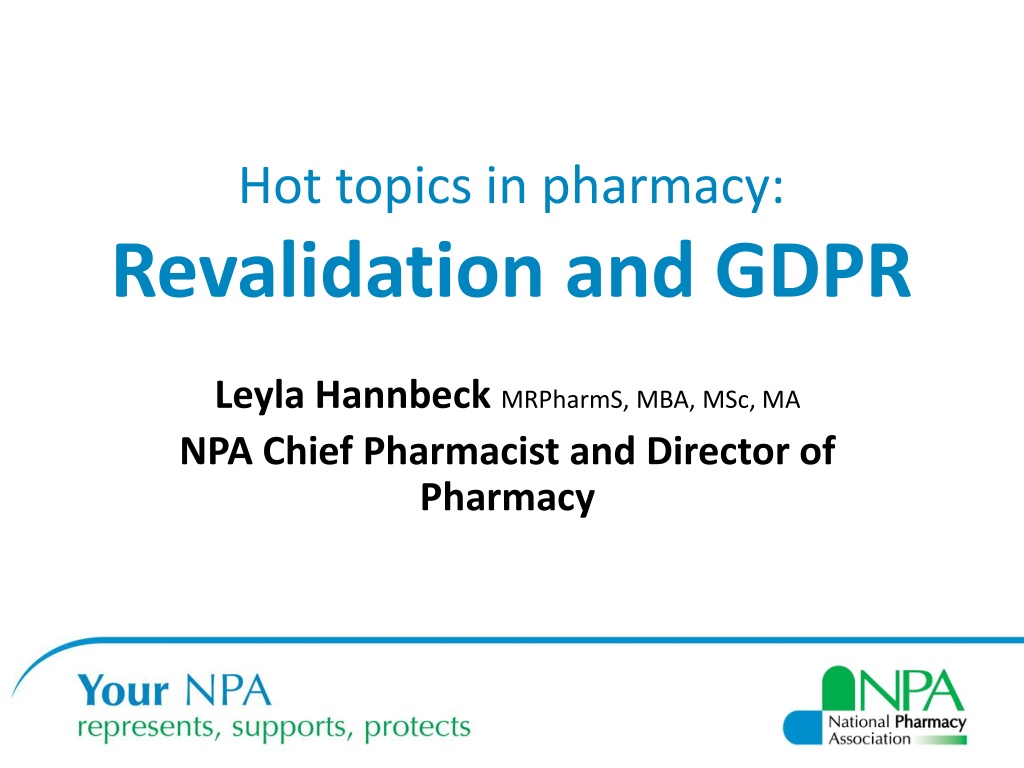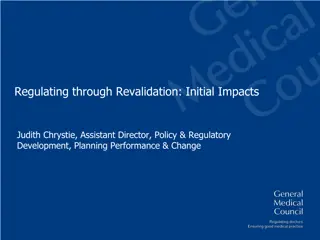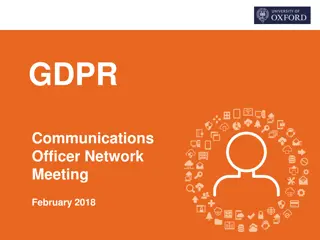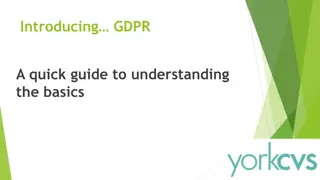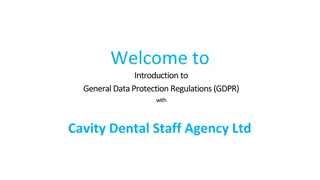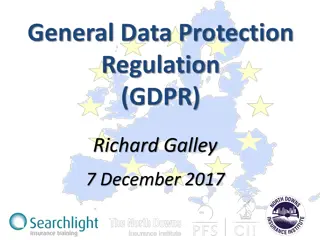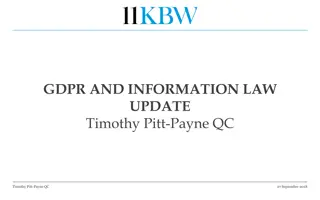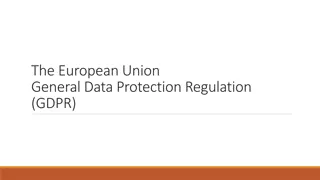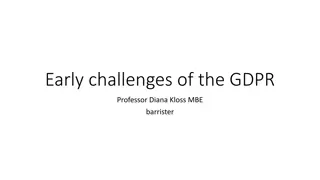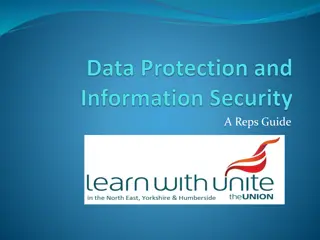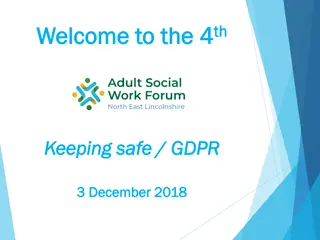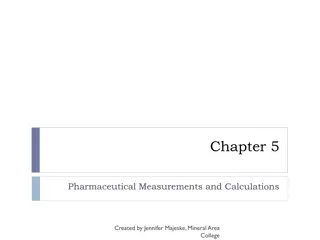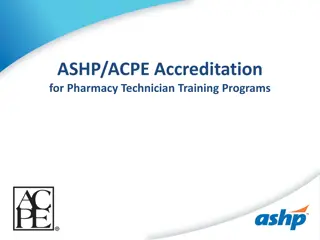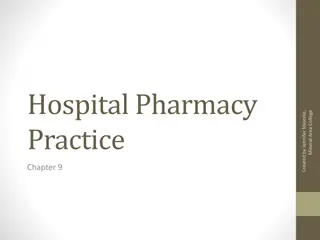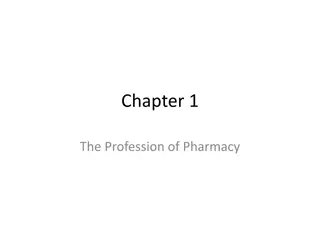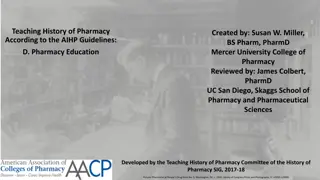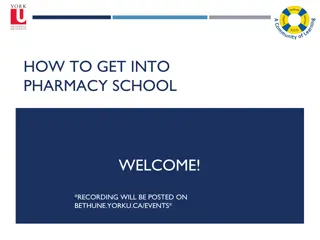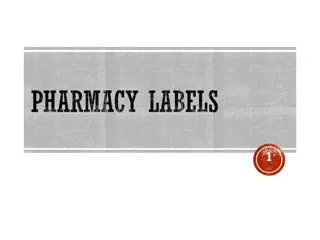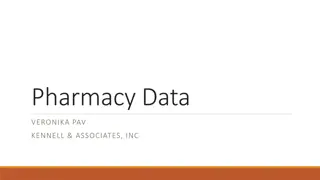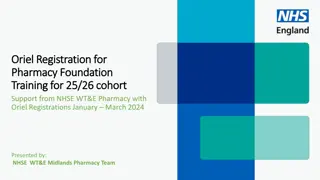Understanding Pharmacy Revalidation and GDPR with Leyla Hannbeck
Explore the key aspects of pharmacy revalidation and GDPR, including its impact, process, new framework, and timeline. Learn why the new revalidation system was implemented, who it affects, and what lies ahead in the implementation process. Gain insights into the requirements for healthcare professionals to demonstrate up-to-date skills and maintain fitness to practice.
Download Presentation

Please find below an Image/Link to download the presentation.
The content on the website is provided AS IS for your information and personal use only. It may not be sold, licensed, or shared on other websites without obtaining consent from the author. Download presentation by click this link. If you encounter any issues during the download, it is possible that the publisher has removed the file from their server.
E N D
Presentation Transcript
Hot topics in pharmacy: Revalidation and GDPR Leyla Hannbeck MRPharmS, MBA, MSc, MA NPA Chief Pharmacist and Director of Pharmacy
What is revalidation? A mechanism for healthcare professionals to demonstrate their skills are up-to-date and that they remain fit to practise
How do we currently complete CPDs? Record online uptodate.org.uk Complete nine CPD entries for each year of registration Submit as part of Call and Review request
New revalidation framework Four CPD records One record of peer discussion One reflective account
Why do we have a new revalidation framework? Public expectations Encourage reflection on learning and practice Increase the focus on outcomes for those using the pharmacy services
Who does it affect? All GPhC registered pharmacists and pharmacy technicians Not affected by individual factors, including: o Part-time employment o Non patient-facing roles o Living/working outside of the UK Does not apply to pre-registration students
Timeline whats happened so far 2010 proposal began for developing revalidation 2014 Advisory group set up made up of representatives from over 30 organisations, including the NPA 2014 to 2017 Research, testing, piloting, and evaluating. This included a 12 Week consultation to obtain feedback from pharmacists and pharmacy technicians December 2017 - Council approved the new revalidation framework
Timeline what lies ahead Early February 2018 Framework to be launched by the GPhC Email to be sent to all registrants to look out for a letter which will be sent in April 30th March 2018 Go live date for revalidation - recording of CPDs can begin Go live date for new online portal CPDs on the old portal will become read-only - registrants can print off old CPD entries 30th June 2018 Old portal goes offline - ensure you have downloaded previous CPD entries
Revalidation framework timeline Implemented from 30 March 2018 If your registration expires on 31 December 2018: 1. You are required to submit only four CPD entries as part of your renewal can only be submitted once your renewal window opens on 1st August 2018 When your registration expires on 31 December 2019, you will be required to submit all six records as part of your renewal which will include one reflective account and one peer discussion 2.
CPD records Each year, pharmacists and pharmacy technicians must submit four CPD entries o At least two must be planned learning activities
Top tips for completing revalidation records: CPD Include a specific learning objective Make it clear how the learning is relevant to your role Explain how the learning will affect individuals using your services Describe learning activities Explain how the learning has been applied Provide examples of the benefits of the learning to service users Provide any feedback or evidence Include any next steps
Leylas CPD planned What are you planning to learn? The new legislation surrounding schools obtaining adrenaline auto-injectors from 1 October 2017 This learning will ensure I am aware of who can request, the requirements of such requests, how to process and record requests and allow me to make a prompt supply to the school, in order to maintain their emergency stocks How are you planning to learn it? I am planning to use the NPA Member News update, NPA Adrenaline auto-injectors supply to schools: FAQs to learn the changes to the Human Medicines Regulation 2012 Give an example of how this learning has been benefited the people using your services. This learning has allowed me to make a prompt supplies of adrenaline auto-injector stock to schools, so that if a child requires administration in an emergency there is stock available I have been able to help schools check the stock they currently have is still within the expiry date and have advised schools on how to produce a legally valid requisition
Leylas CPD unplanned Describe an unplanned event or activity that enabled you to learn something new or refresh my knowledge or skills. Whilst dispensing a prescription for amoxicillin to a patient on regular methotrexate, an interaction flagged on the system I was not aware of an interaction and the PMR system provided minimal information Using a range of resources to find out more, such as the severity of the interaction, what could be the outcome and any practical/clinical actions needed I used product SPCs, BNF and Stockleys to research and found that amoxicillin leads to reduced clearance of methotrexate and potential acute methotrexate toxicity Give an example of how has this learning benefited the people using your services. I was able to discuss the interaction with the prescriber and provide advice and my opinion on how to proceed, including the options to continue with the prescription but increase monitoring to twice weekly This ensured the patient would be closely monitored during treatment and any signs of toxicity would be picked up before any harm was caused
Peer discussion Each year, pharmacy professionals must submit one record of a peer discussion A peer discussion is an activity undertaken through engagement with others, involving reflection on learning and practice However a peer review is a learning and development activity that encourages engagement and involves an assessment of performance
Peer discussion Peer discussions should: Be open and honest Relate to activities from the past year Help you reflect on your practice to help make improvements
Top tips for completing revalidation records: peer discussion Include a description of why this peer was chosen Explain how the peer discussion has helped you reflect on your practice Describe changes made to your practice as a result Provide examples of how the changes implemented have positively impacted and benefited your service users Be between 200- 400 words (but there is no minimum or maximum)
Leylas record peer discussion Describe how this peer discussion changed your practice for the benefit of the people using your services My peer discussion was undertaken with the NPA Chairman, Ian Strachan I chose Ian as my peer as he has an insight to my work stream My peer discussion focussed on improving patient safety in community pharmacy, as part of my role as Medication Safety Officer - we also discussed examples of patient safety work I have conducted and the feedback from my peer has helped me identify areas for improvement I have shared this learning with other pharmacists in the NPA Pharmacy Team, as I now plan to delegate more roles to other teams members, where possible Overall, this will help improve future patient safety projects and therefore improve the resources and support I provide the NPA members
Reflective account Each year, pharmacists and pharmacy technicians must submit one record of a reflective account A reflective account is an activity designed to encourage pharmacists and technicians to think about the way in which they work in relation to the GPhC standards
GPhC Standards Provide person-centred care Work in partnership with others Communicate effectively Maintain, develop and use their professional knowledge and skills Use professional judgement Behave in a professional manner Respect and maintain the person s confidentiality and privacy Speak up when they have concerns or when things go wrong Demonstrate leadership
Reflective account The reflective account should include: How one of more of the GPhC standards for pharmacists and pharmacy technicans have been met A summary of you practice from the past year Examples of how individuals using your services have benefited
Top tips for completing revalidation records: reflective account Describe the setting of your practice and your main roles Include a description of the typical users of your service(s) Explain how you have met the GPhC standard(s) for pharmacy professionals Include examples Include any feedback or evidence
Leylas record reflective account Provide a reflective account of how you met one or more of the Standards for Pharmacy Professionals this particular record is ion regards to Standard 3 communicate effectively . I am the NPA Chief Pharmacist /Director of Pharmacy and manage a team of pharmacists My service users include; NPA members, superintendents, the NPA board and other healthcare professionals and health organisations Effective communication is vital in my role everyday in a wide variety of situations such as discussing issues/advising my team and other healthcare professionals A good example of my ability to effectively communicate discussing the top patient safety concerns, analytics of the patient safety reports submitted to the NPA and ongoing legal cases with the other MSO at the Patient Safety Group We all discussed these topics and were able to communicate ideas with each other in order to then cascade the concerns to community pharmacists and in the best manner
Review of records All records go through an automatic checking process Minimum of 2.5% of registrants selected for full review Reviewed against set criteria Core Feedback
Review of records Undertaken by a pharmacy professional and lay reviewer May be required to submit further information to verify records Tailored feedback provided No feedback score
NPA resources Suite of supportive resources will be made available for members Overview and FAQs Templates Examples and case studies Suggested reading and learning topics NPA will aim to act as a peer or contact point for potential peers to assist in making arrangements for a peer discussion
Next steps 1. Start to think about CPD topics use the NPA resources for ideas 2. Begin thinking about finding a peer think who would be most suitable? 3. Watch out for the new GPhC onlineportal once it is available, become familiar with the system 4. Plan a timeline by which you want to have each of the six records completed by, in time for your registration renewal date be prepared
How long will it take to complete the six records and when do these need to be submitted by? For CPD records, approximately 4.5 hours For the peer discussion (including arranging the discussion and the write up) 2 to 5 hours o The peer discussion itself is expected to be around 30 minutes to one hour For the reflective account, approximately an hour These records must be submitted each year, at the same time registration renewal is completed
If I miss the submission deadline or I cannot complete/submit all the records, will I be able to renew my registration? When renewing registration, registrants must declare that you will comply with the revalidation framework If unable to submit some/all records - inform GPhC in advance of renewal Dependant on individual circumstances/reasons, may still be able to renew registration Without good reasons, you will enter a remediation process
How will the records submitted be reviewed and will feedback be provided? All submissions undergo an automatic check to ensure all records are complete Sample of submissions are selected for review o Informed if selected for review and when to expect the outcome o Reviewed against GPhC criteria o Peer contacted o Undertaken by pharmacy professional and lay reviewer o A feedback report will be provided
Who are the service users? Dependent on the pharmacists and pharmacy technicians area of practice This can include: Patients Patient family and carers Health and non-health professional colleagues Students/trainees Organisations Include direct and indirect recipients
Who can be a peer and how do I find a peer? A number of examples: Another pharmacist/technician Another health professional A non-health professional that has an insight into your role Someone you work with A group of individuals in a similar role Not an individual with which you have a close relationship with (such as a family member or friend)
How is a reflective account different from a CPD record? Reflective account: type of learning that focuses on how the individual meets one or more of the GPhC standard(s) for pharmacy professionals CPD entries: type of learning that does not need to focus on the GPhC standards but it must be relevant to the individuals practice
What will happen to my previous CPD records on the uptodate.org system? Under new framework only submit records for the previous year Records on the uptodate.org system will not be transferred to the new online portal Ability to print a copy of records on the uptodate.org system Uptodate.org system will turn off on 30 June 2018
GDPR (what we know so far)
Presently data protection law is governed by: Data Protection Directive European directive providing the basis of data protection in Europe Data Protection Act 1998 (DPA) Implementation of the EU directive UK law in force since 2000
Data protection law: what is changing? General Data Protection Regulation (GDPR) Applies from 25th May 2018 + Data Protection Bill 2017 Currently passing through UK parliament Data Protection Directive Data Protection Act 1998 (DPA)
GDPR: brief overview Implementation date: 25 May 2018 Many concepts and principles similar to existing DPA New elements and significantly enhanced requirements Key changes include: Updated data protection principles and scope Updated conditions for processing data New rules regarding consent Enhanced data subject rights New, specific legal responsibilities for organisations processing children s data New obligations for data controllers and processors New addition of the accountability principle and the role of the Data Protection Officer Greater regulation and enforcement
Data Protection Act The General Data Protection Regulation Only applicable in UK Applies to all EU countries No requirement for a data protection officer (DPO) Appointment of a data protection officer (DPO) required for certain organisations Consent: does not necessarily require positive opt-in Consent: must be specific, positively opted-in and not implied Covers personal data and sensitive personal data Covers personal data and special categories of data (which includes genetic/biometric data, location data and online identifiers) Responsibility lies predominantly with the data controller Responsibility lies with both the data controller and processor Comparably less accountability Accountability principle explicitly defined Subject access requests: 10 and within 40 days Subject access request: free of charge and within 30 days
GDPR: personal data Personal data includes: Information manually held in filing systems Automated personal data Special categories of personal data Similar to the concept of sensitive personal data under the current DPA GDPR includes genetic/biometric data where it is processed to identify an individual
GDPR: application GDPR applies to: Exemptions to GDPR: All data controllers and data processors Certain activities are exempt from GDPR requirements including those: A data controller determines how and why personal data is processed A data processor carries out the processing on behalf of the data controller Covered by the Law Enforcement Directive Used for national security purposes Carried out by individuals purely for personal/household activities
GDPR: Lawful basis for processing 1. Data subject provides consent to the processing of their personal data for one/more specific purposes 2. Data processing is necessary due to a contract in place or prior to an individual entering into a contract 3. Data processing is necessary for compliance with a legal obligation to which the controller is subject 4. Data processing is necessary to protect the vital interests of the data subject /another natural person 5. Data processing is necessary for the performance of a task undertaken in public interest or to exercise of official authority vested in the controller 6. Data processing is necessary for the controller/third party legitimate interests;except where the data subject s rights and freedoms overrides it, particular if the data subject is a child this does not apply to data processing by public authorities in the performance of their tasks
GDPR: consent Must be Cannot be Given freely, be specific, informed and unambiguous Assumed from the individual s lack of action/response Obtained by clear affirmative action Through pre-ticked consent boxes Verifiable and positively opted-in Obtained by default or by using opt- out boxes Simple/straightforward to withdraw consent Part of any terms and conditions of a service Consent: May not always be required remember there are five other lawful bases permitting the processing of an individual s personal data Must be obtained where another lawful basis for data processing is not applicable
GDPR: consent The Information Commissioner s Office (ICO) recommendations: Regularly review and update consent and associated procedures (as necessary) There is no set time limit/expiry date for consent validity Keep records of evidence Including the name of individual providing consent, how consent was provided and date/purpose for consent
GDPR: individual rights The rights of individuals under the GDPR are similar to those under the DPA; however, there are notable enhancements The GDPR provides eight rights for individuals Not all of the rights are absolute some rights are only applicable in certain circumstances When responding to an individual s request to exercise their individual right, organisations must comply within a definitive time frame
GDPR: complying with an individuals request to exercise their right Take reasonable steps to verify the identity of the individual Comply without undue delay and within specified time frames Organisations must provide the information electronically, where possible Provide the information free of charge
GDPR: individual rights 1. The right to be informed 2. The right of access 3. The right to rectification 4. The right to erasure 5. The right to restrict processing 6. The right to data portability 7. The right to object 8. Rights in relation to automated decision making including profiling
How to demonstrate compliance Implement appropriate technical and organisational measures Maintain relevant documentation on processing activities Appoint a data protection officer (DPO) Use data protection impact assessments (where appropriate)
